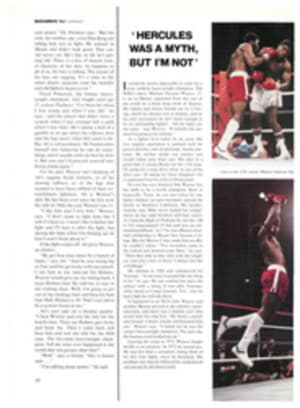
A FORMULA TO LIFT THE SPIRITS AND BEAT INFLATION: GO BACK TO NATURE
I've taken so many camping trips in my life that the memories of most of them have merged and blurred in my mind. There were two trips, though, that I'll never forget, because I think they demonstrate the extraordinary range of possibilities open to Americans who want to enjoy the out-of-doors.
A few years ago a friend invited my son and me to go with him to visit 2,000 acres of land that he owned east of the town of Red Bluff, Calif. This was Yahi Indian country, where Ishi—the last wild Indian in North America—was discovered just over half a century ago.
We drove down the old Lassen Trail for the first 15 miles out of Red Bluff, and it was tough country even for our Jeep. When we could drive no farther, we hiked in a few more miles over steep hills and difficult ridges. Though the three of us were in good physical condition, we were exhausted when we finally found a suitable campsite—an Indian cave at the edge of a steep cliff, high above a clear, fast-flowing creek. It was obviously a cave that the Yahi had used, because its roof was blackened with soot from campfire smoke and a perfectly formed bowl had been carved into its stone floor.
We slept on that floor and lived on dried fruit that we'd brought along and trout that we caught in the creek on dry flies. Our firewood and water had to be hauled up to the cave each day, a steep climb of more than an hour. The mountains and cliffs were dotted with caves and, between fishing expeditions, we explored a number of them. In one we discovered wooden drying racks that the Yahi had used for fish and venison perhaps 100 years ago. In the three days we camped there we saw hundreds of deer. The only sounds—besides our own voices and footsteps—were the creek, the wind, the large coveys of mountain quail and occasional owls. Once, at night, a cougar screamed.
The second trip also lasted three days. A friend who owned a large camping trailer invited my wife and me to join him, and we camped about 200 miles south of the Yahi cave, in Yosemite National Park.
Upon entering the park on a Friday morning, we were greeted by a traffic jam complete with screaming, red-faced drivers, blaring horns and exhaust fumes. Though it was still early summer, our campsite had already been so heavily used that the grass had been worn away and the earth pounded into dust. But we slept and dined in comfort, eating elaborate meals cooked over a stove that was at least as large as the gas range in our kitchen at home. The fishing we did was for stocked trout, and the favored baits were marshmallows and cheese balls. On a long hike we saw some spectacular country, a lot of people and one lost dog, a howling Labrador. The sounds to which we became accustomed over the three-day period were of radios and record players, an electric guitar, portable generators, trail bikes and, of course, the thousands of recreational vehicles that streamed along the well-paved roads. Once, at night, a woman screamed. We later learned she had cut herself with an electric carving knife.
Thoreau drew the obvious conclusion long ago: "Most of the luxuries, and many of the so-called comforts, of life are not only not indispensable, but positive hindrances to the elevation of mankind." Aldo Leopold comes closer to the central point when, in A Sand County Almanac, he relates this doctrine of simplicity specifically to nature. The value of an outdoor experience, he contends, is in direct proportion to the degree of contrast it affords us with our daily lives. In other words, we go out into nature to temporarily escape the complexities of civilization and, in the process, refresh and renew ourselves. But by dragging a 40-foot trailer full of civilization with us and parking it in an outdoor ghetto, are we not defeated before we begin? Thus, not surprisingly, I found my trip to Yahi country exhilarating despite the hardships—or, rather, because of them. And modern-day comforts and conveniences were largely responsible for making our Yosemite excursion unsatisfying.
While not everyone is willing or physically able to endure the hiking and hauling required to visit a remote area like Yahi country, some sort of wilderness is accessible to nearly everyone. Campsites that offer no amenities except a place to pitch a tent—perhaps near a stream or lake—can be enormously pleasant to an inexperienced, less confident camper without causing him extreme hardship. At the end of a day spent fishing or simply exploring, easy conversation around the campfire is infinitely more enjoyable than watching battery-powered television inside a motor home.
What is it that has led so many American campers to forsake the tranquillity celebrated by Thoreau and Leopold in favor of driving eight-mile-per-gallon motor homes along smoggy freeways to overcrowded campgrounds and parks? Blame it on frenzied growth. One clear indication of the increase in outdoor recreation in this country is the fact that the operating budget of the National Park Service the year after World War II ended was $5 million. In 35 years that budget has increased to more than $500 million.
The manufacturing of recreational equipment also reflects this fantastic growth. After World War II we became a nation of consumers with a lot of free time on our hands, and the people who make motor homes, four-burner camp stoves, trail bikes and motor-boats are like the people who make most anything else—they will produce and sell us whatever they are able to convince us we should have.
But now, with the increase in the price of oil and gasoline, and the inflation resulting from it, there's a shortage of spending money. More or less coinciding with our economic problems—and in some ways related to them—there has been a gradual change in the attitudes of both the government and private sectors in regard to the administration of public lands. Though this may be bad news for the makers and sellers of recreational vehicles and related gadgetry, it could be beneficial for our national parks and the people who use them.
Yosemite may lead the way toward a happier future for those who wish to truly experience the out-of-doors. A master plan for Yosemite has been drawn up by the Park Service with considerable help from the public, and its goal is to enhance the natural beauty of the park by reducing automobile use.
Under the plan, day visitors would be required to leave their vehicles in lots and travel through Yosemite by bus, and a limit would be set on the number of people allowed in each day. Because 90% of the park's visitors spend most of their time in the seven square miles of Yosemite Valley (the total park is 1,189 square miles), the Park Service hopes eventually to exclude all private vehicles from this area.
More stringent rules have been established for overnight use, too, and a system of permits and reservations will cut down the long lines of vehicles waiting for vacancies.
Another plan to reduce overcrowding will involve $100 million in private funds. The Park Service feels that its stores, warehouses and offices in Yosemite Valley are largely responsible for the congestion there, and it hopes to demolish some of the buildings and relocate the facilities on less scenic ground, perhaps beyond the park boundaries. The Park Service will not ask Congress for the funds needed to relocate the buildings. Instead, a private nonprofit organization called the Yosemite Institute will attempt to raise the money for the project. Then the Federal Government will lease the facilities, gradually repay the $100 million along with interest and eventually reassume ownership of the facilities.
It remains to be seen whether these plans will be implemented and how the public will accept them if they are. I think many people will heartily approve. And I hope that Yosemite's effort will inspire similar plans elsewhere. I'd like to believe that the trend back toward the concepts expressed by Thoreau and Leopold has only begun.
I've always wanted to return to Yahi country; now another trip to Yosemite has strong appeal, too.

